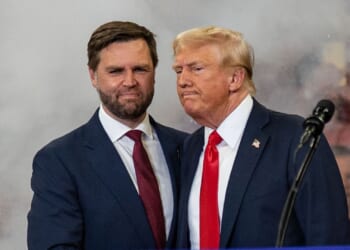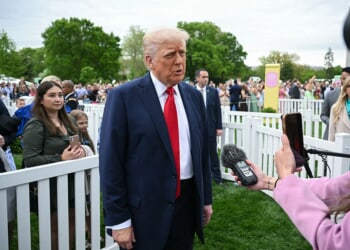America is undergoing a profound transformation. Gone are the days of reckless deficit spending and bloated government. In their place: fiscal consolidation, industrial renewal, and a return to assertive trade policy. A review of the economic agenda from President Trump’s first 100 days tells a striking story.
On January 20, 2025, Donald Trump assumed office from his Democratic predecessor Joe Biden, inheriting a fiscal mess of historic proportions: public debt at 120 percent of GDP, a staggering 8.4 percent deficit in the previous year, and a swollen administrative state. Biden’s fiscal conduct can only be described as a shameless vote-buying spree — a bonfire of borrowed billions set atop a rickety bridge to nowhere. Those who govern by this playbook (look no further than Berlin) are either political opportunists or dyed-in-the-wool Keynesians. A basic grasp of math and economics suffices to expose the fatal flaw: this road leads straight to sovereign default.
America First: The Return of Industry
Let us look forward. Trump’s economic reform agenda is simple in essence: limit government to core functions like national defense and internal security, unleash the private sector by cutting red tape, and strip the state of ideological ballast. The linchpin of this plan is the U.S. Treasury, led by Scott Bessent, a seasoned Wall Street executive. His mission: keep $36 trillion in federal debt afloat, enforce austerity, and ease the tax burden — all at once.
Sweeping tax cuts for households and businesses will complement the new tariff regime enacted in April. But this strategy requires painful but necessary budget cuts. In coordination with the Department of Government Efficiency (DOGE), the administration has already identified $163 billion in annual savings. Add in an estimated $150–200 billion per year in new tariff revenues, and Bessent has the fiscal room to ease the tax load while reining in federal spending. The tax reform package is already winding its way through Congress.
In April, lawmakers approved the extension of Trump’s first-term tax cuts, worth $4.5 trillion, and authorized spending reductions of $1.5 trillion — a preliminary but meaningful step toward rebalancing the federal budget. The long-term goal: to fundamentally recalibrate the balance of power between citizens and the state. At the far end of this process could lie the complete abolition of federal income tax — a rollback of FDR’s “Europeanization” of America and a return to pre-New Deal fiscal liberty. Roosevelt exploited the Great Depression to install a European-style welfare regime whose size has grown in lockstep with taxation ever since. Today, Trump charts the path back to basics.
Reindustrialization: The Cornerstone of Renewal
Still, Trump’s team walks a tightrope. The U.S. economy must be revived amid global stagnation. Europe is visibly slowing, and Germany teeters on the edge of recession. China, too, is wobbling. In this climate, Trump’s reindustrialization drive is pivotal. After decades of industrial decay, America is hitting reverse — and fast.
The strategy: a mix of tariffs and targeted fiscal incentives to coax capital back onshore — carrot and stick. The aim is not to become a cheap global workshop, but to lead the next generation of strategic industries. Semiconductor giants like Nvidia (planning $500 billion in U.S. investments this year alone) and Intel are spearheading this charge, shifting massive capital flows back home. The target sectors: AI, robotics, medical and propulsion tech, and next-gen data centers.
Dismantling the Leviathan
Cuts to government spending inevitably cause short-term disruptions. Predictably, Keynesian pundits reveled in the 0.3 percent drop in U.S. GDP in Q1. But this decline was driven by import front-loading and the start of deep budget reductions. And GDP, as framed by Keynesian orthodoxy, is little more than economic hocus-pocus. Government spending is merely the diversion of real resources from the productive sector toward consumption and bureaucracy. Reducing the state’s footprint is not recessionary — it is restorative. True economic growth stems from private investment, not government bond issuance.
Germany, meanwhile, assumes the role of antagonist. During Olaf Scholz’s tenure, the public sector ballooned, and the state’s share of GDP hit 49.5 percent. His successor Friedrich Merz is following the same ruinous course, proposing a €1 trillion debt package as a response to stagnation. Despite his image as a market-friendly conservative, Merz is a Keynesian through and through — surrounded in Berlin by like-minded spendthrifts who still believe they can borrow their way out of both debt and stagnation. A glance at the economic history of the 20th century would suffice to discredit this fantasy. This ideology has already submerged the West in a sea of debt.
Confidence Returns to the U.S.
Back in Washington, the White House reported a stunning $5 trillion in private-sector investment commitments during the first 100 days — about 120 percent of Germany’s entire GDP. These will create over 450,000 new jobs. The April investment surge confirms the trend: capital expenditures rose by 22 percent year-over-year. These are growth figures most European countries can only dream of. Germany, by contrast, has seen a $60–100 billion annual hemorrhage of direct investment, driven by energy chaos, uncontrolled immigration, and spiraling social costs — all met with political indifference.
The lesson is straightforward: It’s the economy, stupid! — a phrase that helped Bill Clinton topple George H.W. Bush. Trump’s surgical defunding of ideological bureaucracies like USAID fits that mold. His government is committed to creating an efficient framework for economic activity, sticking to essential state functions, and otherwise getting out of people’s way.
The Market Strikes Back
After just 100 days, Trump’s second term is shaping up to be a watershed in U.S. economic policy. We are witnessing the return of free-market capitalism and a reawakening of the civilizing force of economic liberty. Prosperity and social vitality flourish where individuals can act freely, not where bureaucrats and tax collectors dominate. Trump is reintroducing this spirit — and unsurprisingly, it’s sending the European statists into fits of ideological rage.
Their reaction? More control. More debt. More regulation. In Berlin and Brussels, Trump’s reforms provoke an almost pathological resistance. The deepening recession in Germany will soon corner its new government into embarrassing explanations — especially when the U.S. economy roars back to life.
READ MORE from Thomas Kolbe:
Falling Oil Prices: Record Output Meets Economic Slowdown
How Germany and the EU Slept Through Trump’s Watershed Moment


![Vivek Gets Confronted by Protestor at GOP Event, Encounter Takes a Surprising Turn [WATCH]](https://www.right2024.com/wp-content/uploads/2025/04/Vivek-Gets-Confronted-by-Protestor-at-GOP-Event-Encounter-Takes-350x250.jpg)
![NYT Tries to Run Cover for Female Black Hawk Pilot... DEI-Driven Military Failures? [WATCH]](https://www.right2024.com/wp-content/uploads/2025/04/NYT-Tries-to-Run-Cover-for-Female-Black-Hawk-Pilot-350x250.jpg)


![NYT Covered for Illegal Alien Accused of Raping a Corpse on NYC Subway [WATCH]](https://www.right2024.com/wp-content/uploads/2025/05/NYT-Covered-for-Illegal-Alien-Accused-of-Raping-a-Corpse-350x250.jpg)

![Trump Posts Hilarious Pope Meme, Leftists Immediately Melt Down [WATCH]](https://www.right2024.com/wp-content/uploads/2025/05/Trump-Posts-Hilarious-Pope-Meme-Leftists-Immediately-Melt-Down-WATCH-350x250.jpg)
![Tulsi Gabbard Opens Official Probe Into Fauci’s COVID19 Cover-Up [WATCH]](https://www.right2024.com/wp-content/uploads/2025/05/Tulsi-Gabbard-Opens-Official-Probe-Into-Faucis-COVID19-Cover-Up-WATCH-350x250.jpg)






